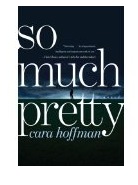 Cara Hoffman’s So Much Pretty explores the aftermath of a kidnapping and killing in a rural New York town. Told from multiple points of view, the story is meant to enrage us against the violence against women that is perpetuated every day.
Cara Hoffman’s So Much Pretty explores the aftermath of a kidnapping and killing in a rural New York town. Told from multiple points of view, the story is meant to enrage us against the violence against women that is perpetuated every day.
I wanted to love this book. It came highly recommended by another book blogger I follow. But while it does tell a compelling story and does highlight the epidemic of violence against women, So Much Pretty fell short of my expectations.
One of the things that makes the book an interesting read is the multiple viewpoints that reveal the story. At the same time, having snippets of insight into the characters kept me from really identifying and empathizing with any of them. I think that was part of what made the book harder for me to read. I was never able to connect closely enough with Stacy Flynn, a reporter who had moved to town to cover an environmental story and becomes obsessed with the kidnap and murder of Wendy White. As a result of this disconnection, the righteous anger at what happened to Wendy- and the commentary on violence against women in general-fell flat. I never quite connected with it.
Alice Piper, a precocious student, seeks her own resolution to the dilemma of accepting violence as a part of life or choosing to fight it. And fight is a deliberate turn of phrase there. I get Alice’s intelligence and quirkiness, and I was rooting for her on some level, but again, the lack of connection to her kept me from really caring a lot about what she decided.
Finally, I thought the local dairy, which employs most people in the town, and its associated environmental issues were going to play a bigger part in the narrative. Instead they are built up to an extent and then largely disregarded. It felt disjointed.
As I write this, though, I wonder if this disconnection, this indecisiveness, isn’t part of what Hoffman intended. There are so many social issues- violence against women chief among them- that have become so commonplace to us that we’re almost indifferent to hearing about them. Perhaps that is the point. Perhaps Hoffman is telling us to wake up, to take a stand, to say that enough is enough. Not to the extreme measures that Alice chooses, but something.
I feel like I owe the book a second read. Or it could just be that this is one that I say is good, but not great. It impacted me enough that I hid a golf club under the bed, just in case. In all honesty, I finished this book months ago, but have put off writing about it because I am not completely sure how I feel about it. Certainly, if you have any interest in literary fiction, in social issues and how society relates to them, then So Much Pretty is worth a read.